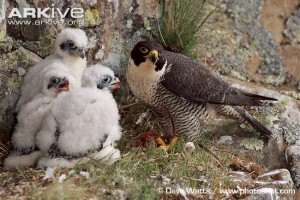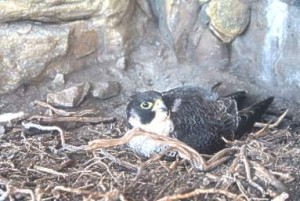BLOG #2
Peregrine Falcon song appears to be innate. Because the juveniles leave the nest early on and do not live in communities with many other raptor birds (they nest secluded with another parent), they do not learn their song from another. At birth, baby Peregrine Falcons exhibit begging calls. These begging calls are pleas for the baby to get food from the parents. Previous scholarship has questioned whether these begging calls produced by the fledgling are honest signals of needing food, means of competing with siblings in the nest for resources, or as an alert to predators to come to the nest if the parents do not feed the fledglings. The collected research seems to point to the conclusion that these calls are honest signals or that fledglings genuinely want food. The fledglings make loud wailing sounds when hungry.
Peregrines also exhibit alerting calls, warning fellow Peregrines about predators in the area. These alert calls may have other purposes however, including recruiting other peregrines for defense of a nest, alerting the predator that the peregrine will fight back, or attracting the predator away from the nest. They make a loud cacking when their is some disturbance near the nest. Peregrines finally exhibit courtship calls. These calls are used during ledge displays and other courting rituals. The sound they make during these displays is an “ee-chup”.
At the nesting site of the Peregrine Falcon two distinct vocalizations are heard from the adult falcons. These two distinct vocalizations are separated into the creaking and the wailing calls. The wailing call consists of a long continuous call that phonetically sounds like a ghiii-ghiii-ghiii-ghiii. Whereas the creaking call consists of a much shorter call with a heavy emphasis on the first syllable with a iiichep sound.
However the wailing call is heard in a variety of circumstances that can be divided into three categories: an antagonistic call, a parental food-call type, and a heterosexual type. Studies show that the wailing call is not gender specific and that it is used by both genders when there is a need to change the social context. Whereas the creaking call is a call used between partners and is only present when the partner is present.
One way to test whether or not the wailing calls of young peregrines are honest signals of hunger is through an observational experiment. If wailing calls are indeed honest signals of hunger, then individuals that have received food should stop wailing. If wailing is a means for competing with siblings for food, then the birds would continue wailing to get more food than their siblings. If wailing relates to need rather than competition, then individuals in larger brood sizes should take longer to satiate than ones in smaller broods because there are more chicks. Alternatively, if wailing relates to competition, then the size of the brood will not matter.
Bibliography
Kouba M, Bartoš L, Štastný K (2014) Factors Affecting Vocalization in Tengmalm’s Owl (Aegolius funereus) Fledglings during Post-Fledging Dependence Period: Scramble Competition or Honest Signalling of Need? PLoS ONE 9(4): e95594. doi:10.1371/journal.pone.0095594
Cade, T. J., J. H. Enderson and Linthicum J. 1996. Guide to Management of Peregrine Falcons at the Eyrie. The Peregrine Fund.
Parejo D, Avilés JM, Rodríguez J. 2012. Alarm calls modulate the spatial structure of a breeding community. Proc Biol Sci 279: 2135-41
Carlier P. 1995. Vocal Communication in Peregrine Falcons Falco-Peregrinus during Breeding. British Ornithologists Union.
Leonardi G, Amato M, Brogna A, Cipriano M, D’Angelo R, Dipasuale G, Mannino V, Ossino A, Andreotti A. 2013. Effectiveness of Vocal Activities of the Lanner Falcon (Falco Biarmicus) During Breeding. Journal of Ornithology
Kirschbaum, K. (2004, November 5). Falconidae Falcons. Retrieved May 4, 2015, from http://animaldiversity.org/accounts/Falconidae/



I work in church cathedral where Peregrine falcons nest it’s beautiful to watch them coming back to the nest this church is in cork city Ireland
that’s really cute bird, is it fat?